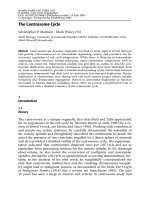The rock cycle
Bạn đang xem bản rút gọn của tài liệu. Xem và tải ngay bản đầy đủ của tài liệu tại đây (444.71 KB, 40 trang )
The Rock
Cycle
Sedimentary Rock
• For thousands, even millions of years, little
pieces of our earth have been eroded-broken down and worn away
by wind and water. These little bits of our
earth are washed downstream where they
settle to the bottom of the rivers, lakes, and
oceans. Layer after layer of eroded earth is
deposited on top of each. These layers are
pressed down more and more through time,
until the bottom layers slowly turn into rock.
Sedimentary Rock - Sandstone
• Sandstone rocks are sedimentary rocks
made from small grains of the minerals
quartz and feldspar. They often form in
layers as seen in this picture. They are
often used as building stones.
Sedimentary Rock - Limestone
• Limestone rocks are sedimentary rocks
that are made from the mineral calcite
which came from the beds of evaporated
seas and lakes and from sea animal
shells. This rock is used in concrete and is
an excellent building stone for humid
regions.
Sedimentary Rock - Shale
• Shale rock is a type of sedimentary rock
formed from clay that is compacted
together by pressure. They are used to
make bricks and other material that is fired
in a kiln.
Sedimentary Rock - Conglomerate
• Conglomerate rocks are sedimentary
rocks. They are made up of large
sediments like sand and pebbles. The
sediment is so large that pressure alone
cannot hold the rock together; it is also
cemented together with dissolved
minerals.
Sedimentary Rock - Gypsum
• Gypsum rocks are sedimentary rocks
made up of sulfate mineral and formed as
the result of evaporating sea water in
massive prehistoric basins. It is very soft
and is used to make Plaster of Paris,
casts, molds, and wallboards.
Igneous Rocks
• Igneous rocks are called fire rocks and
are formed either underground or
above ground. Underground, they are
formed when the melted rock, called
magma, deep within the earth becomes
trapped in small pockets. As these
pockets of magma cool slowly
underground, the magma becomes
igneous rocks.
• Igneous rocks are also formed when
volcanoes erupt, causing the magma to
rise above the earth's surface. When
magma appears above the earth, it is
called lava. Igneous rocks are formed
as the lava cools above ground.
Igneous Rock - Granite
• Granite rocks are igneous rocks which
were formed by slowly cooling pockets of
magma that were trapped beneath the
earth's surface. Granite is used for long
lasting monuments and for trim and
decoration on buildings.
Igneous Rock - Scoria
• Scoria rocks are igneous rocks which were
formed when lava cooled quickly above
ground. You can see where little pockets
of air had been. Scoria is actually a kind of
glass and not a mixture of minerals.
Igneous Rock - Pumice
• Pumice rocks are igneous rocks which were
formed when lava cooled quickly above ground.
You can see where little pockets of air had been.
This rock is so light, that many pumice rocks will
actually float in water. Pumice is actually a kind
of glass and not a mixture of minerals. Because
this rock is so light, it is used quite often as a
decorative landscape stone. Ground to a
powder, it is used as an abrasive in polish
compounds and in Lava© soap.
Igneous Rock - Pumice
Igneous Rock - Obsidian
• Obsidian rocks are igneous rocks that
form when lava cools quickly above
ground. Obsidian is actually glass and not
a mixture of minerals. The edges of this
rock are very sharp.
Metamorphic Rock
• Metamorphic rocks are rocks that have
"morphed" into another kind of rock. These
rocks were once igneous or sedimentary
rocks. How do sedimentary and igneous
rocks change? The rocks are under tons and
tons of pressure, which fosters heat build up,
and this causes them to change. If you exam
metamorphic rock samples closely, you'll
discover how flattened some of the grains in
the rock are.
Metamorphic Rock - Schist
• Schist rocks are metamorphic. These
rocks can be formed from basalt, an
igneous rock; shale, a sedimentary rock;
or slate, a metamorphic rock. Through
tremendous heat and pressure, these
rocks were transformed into this new kind
of rock.
Metamorphic Rock - Gneiss
• Gneiss rocks are metamorphic. These
rocks may have been granite, which is an
igneous rock, but heat and pressure
changed it. You can see how the mineral
grains in the rock were flattened through
tremendous heat and pressure and are
arranged in alternating patterns.
Metamorphic Rock - Gneiss
1
Igneous rock is broken down into sediment
by weathering and erosion. This sediment
is washed into rivers by rain and it settles at
the bottom of the rivers. Over time, more
layers of sediment are added. The weight
of all the layers presses them together and
they eventually harden forming sedimentary
rock.
2
The sedimentary rock is pushed deeper into
the earth. This adds to the pressure from
the weight from above. It also moves closer
to the heat of the magma stored in the deeper
layers of the earth. This pressure and heat
combined forces the sedimentary rock to
completely change and it becomes
metamorphic rock.
3
If the metamorphic rock reaches the hotter
magma, it will completely melt and become
part of the magma. The magma travels along
underground pathways which will eventually
find its way out to the surface through
volcanoes. When the magma hits the surface,
it becomes lava and begins to cool. The
cooled lava forms what is known as igneous
rock.
The cycle starts all over
again.
Let’s see what you remember.
I am made up of bits and pieces of many
different types of rocks. I started forming in
the bottom of a river, but I was eventually
pushed underground where I hardened into
rock. I contain fossils, which gives people a
peek at what life was like millions of years ago.
A sedimentary rock
B igneous rock
C metamorphic rock









